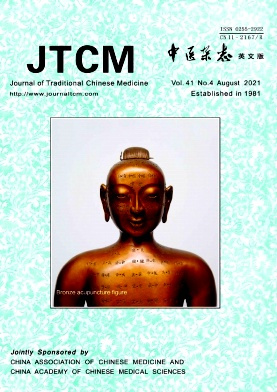
Journal of Traditional Chinese Medicine投稿地址
Journal of Traditional Chinese Medicine詳細信息
Journal of Traditional Chinese Medicine
Journal of Traditional Chinese Medicine
Journal of Traditional Chinese Medicine投稿要求
Journal of Traditional Chinese Medicine雜志投稿須知:Abstract;A concise and factual abstract is required. The abstract should state briefly the purpose of the research, the principal results and major conclusions. An abstract is often presented separately from the article, so it must be able to stand alone. For this reason, References should be avoided, but if essential, then cite the author(s) and year(s). Also, non-standard or uncommon abbreviations should be avoided, but if essential they must be defined at their first mention in the abstract itself.Keywords;Immediately after the abstract, provide a maximum of 6 keywords, using American spelling and avoiding general and plural terms and multiple concepts (avoid, for example, 'and', 'of'). Be sparing with abbreviations: only abbreviations firmly established in the field may be eligible. These keywords will be used for indexing purposes.Abbreviations;Define abbreviations that are not standard in this field in a footnote to be placed on the first page of the article. Such abbreviations that are unavoidable in the abstract must be defined at their first mention there, as well as in the footnote. Ensure consistency of abbreviations throughout the article.Acknowledgements;Collate acknowledgements in a separate section at the end of the article before the references and do not, therefore, include them on the title page, as a footnote to the title or otherwise. List here those individuals who provided help during the research (e.g., providing language help, writing assistance or proof reading the article, etc.).Math formulae;Please submit math equations as editable text and not as images. Present simple formulae in line with normal text where possible and use the solidus instead of a horizontal line for small fractional terms, e.g., X/Y. In principle, variables are to be presented in italics. Powers of e are often more conveniently denoted by exp. Number consecutively any equations that have to be displayed separately from the text (if referred to explicitly in the text).Footnotes;Footnotes should be used sparingly. Number them consecutively throughout the article. Many word processors can build footnotes into the text, and this feature may be used. Otherwise, please indicate the position of footnotes in the text and list the footnotes themselves separately at the end of the article. Do not include footnotes in the Reference list.
Journal of Traditional Chinese Medicine雜志簡介
《中醫雜志(英文版)》(季刊)(Journal of Traditional Chinese Medicine )創刊于1981年,由中華中醫藥學會和中國中醫科學院主辦。
《Journal of Traditional Chinese Medicine》關鍵主題包括針灸和電針,草藥,順勢療法,地方療法,心理身體治療,姑息治療和其他CAM療法。
《Journal of Traditional Chinese Medicine》始終堅持發揚中醫特色,以中醫學術為本,同時推動和關注中醫現代研究和中西醫結合研究的發展;提高為主,兼顧普及;面向臨床,兼重基礎理論的正確辦刊方針。本刊早在20世紀80年代就已經成為部級核心期刊,并多次在全國科技期刊評比中獲獎。
《Journal of Traditional Chinese Medicine》于2010年起被列為美國《科學引文索引(擴展庫)》(SCI-E)來源期刊。這是我國中醫期刊第二本SCI來源期刊,將對促進中醫藥國際化發展、中醫標準化建設進程和國內中醫藥期刊質量提高起到積極的作用。
Journal of Traditional Chinese Medicine統計分析
影響因子:指該期刊近兩年文獻的平均被引用率,即該期刊前兩年論文在評價當年每篇論文被引用的平均次數
被引半衰期:衡量期刊老化速度快慢的一種指標,指某一期刊論文在某年被引用的全部次數中,較新的一半被引論文刊載的時間跨度
他引率:期刊被他刊引用的次數占該刊總被引次數的比例用以測度某期刊學術交流的廣度、專業面的寬窄以及學科的交叉程度
引用半衰期:指某種期刊在某年中所引用的全部參考文獻中較新的一半是在最近多少年時段內刊載的
平均引文數:在給定的時間內,期刊篇均參考文獻量,用以測度期刊的平均引文水平,考察期刊吸收信息的能力以及科學交流程度的高低
熱門評論
有種相見恨晚的感覺,是一種良好的自然語言處理的讀物,也讓我領略了學術之美,讓我有更濃厚的興趣去學習我們所設計的學術領域,不足之處,可能本書偏向道的講述,有一些技術細節沒有完成解釋清楚,不過這也是難免的。
審稿人能夠準確指出,文章存在的不足,并提出修改建議。Journal of Traditional Chinese Medicine有兩個審稿人,一個審稿人給出比較肯定的意見,一個建議修后再審,然后就再審了。最后修改后給的錄用。
個人認為Journal of Traditional Chinese Medicine是不錯的雜志,編輯真的很認真負責,由于本人文字功底較差,編輯將文章從頭改到尾,連標點都沒拉下。說實話,老板都沒這么認真負責,哈哈。不說了,頂一下。
給出了非常詳細的審稿意見,因自身原因無法在該刊物上發表。但專家給出的詳細及專業的建議卻是同期刊中較為認真負責的。對Journal of Traditional Chinese Medicine雜志老師表示歉意,希望能越辦越好。
Journal of Traditional Chinese Medicine雜志審稿速度非常快。只要提交就行。拒稿率很低,直接死在編輯手里的文章都是少數,兩位審稿人,意見比較中肯。但文章出版速度較慢,一般要近1左右的時間。總體來說是一本不錯的期刊。
以前中過一篇,稿件處理速度非常快,就2個月左右,修改稿上傳后直接錄用。給我印象就是審稿還是很專業的,一個審稿人,因為現在中國人搞學術水平已經很高了,所以國內審稿人的水平就很高,給的意見的水平也是一流的。對文章提升很大。校稿的時候編輯還主動電話聯系我討論文章格式問題,非常負責而且很高效!
作者筆觸獨到,觀點鮮明,擲地有聲!類似講這方面的書浩如煙海,不過看看這本作品還是有耳目一新的感覺。我真是太喜歡Journal of Traditional Chinese Medicine,閱讀起來酣暢淋漓又發人深省。
該期刊有些小的創新點就能發,審稿速度較快,基本1個半月給消息,錄用了再交審稿費,這個必須贊一個;不論是審稿專家,還是責任編輯,都很認真,這個也得贊一個。
Journal of Traditional Chinese Medicine雜志主編和各位編輯非常NICE,投稿后,第二天就送審,中途經歷了專家拒審和超時,幫換專家外審,文章經過小修后錄用,非常開心!第一次投核心雜志就中了!
一直買Journal of Traditional Chinese Medicine,挺好的,印刷好,圖片清晰,內容也不錯,價格實惠,送書速度也快,我很喜歡看這類經濟書,以后會常來投稿網。有需要的,就下手吧,真的很不錯。
相關問題
- Journal of Traditional Chinese Medicine是正規期刊嗎?
- Journal of Traditional Chinese Medicine是什么級別的期刊?是核心期刊嗎?
- Journal of Traditional Chinese Medicine評職稱可以嗎?單位認可嗎?
- Journal of Traditional Chinese Medicine是北大核心嗎?是中文核心嗎?
- Journal of Traditional Chinese Medicine是科技核心嗎?
- Journal of Traditional Chinese Medicine是統計源核心嗎?
- Journal of Traditional Chinese Medicine是南大核心CSSCI嗎?
- Journal of Traditional Chinese Medicine是CSCD期刊嗎?
- Journal of Traditional Chinese Medicine是國家級期刊嗎?
- Journal of Traditional Chinese Medicine是SCD期刊嗎?
- Journal of Traditional Chinese Medicine是國家新聞出版署第一批、第二批學術期刊嗎?
- Journal of Traditional Chinese Medicine好投嗎?Journal of Traditional Chinese Medicine簡介
相關期刊
更多常見問題
| Q:論文發表的時候可以一稿多投嗎? |
| A:一稿多投的行為是典型的學術不端的行為,是國內外學術界都明令禁止的行為,原因主要在于涉及到文章版權歸屬的問題,如果作者的文章已經被某個雜志社錄用,或者同時被兩家雜志社錄用,就會涉及到版權糾紛,作為雜志社都會保護本社的合法權益,到這時作者就會比較麻煩,吃官司都是小事兒了,被打入黑名單降級降職影響可就太大了。 |
| Q:職稱論文發表對時間有限制嗎? |
| A:職稱論文發表并沒有明確規定截止時間,需要作者結合自己所在地區的具體規定自己安排發表時間,一般職稱評審,各地區都會明確規定申報材料的最后期限和截止日期,我們結合這個日期來考慮何時發表文章就可以,大部分地區職稱評審都集中在每年的8-10月之間,有的地區要求7月中旬開始交材料,最晚8月底之前,有的則是要求8月中旬交,還有部分地區要求截止時間為申報時間上年的12月31日,所以,各個地區的具體要求并不同,申報者需要在提交材料前確保自己的文章已經見刊并且被相應的數據庫檢索即可。 |
| Q:網上發表論文如何防騙?可靠網站與可疑網站如何區分? |
| A:由于發表論文的需求遠遠多于雜志版面的供應,再加上眾所周知的審稿難!審稿慢!選擇論文發表網站發表表論文確實能解決以上問題。賣方市場的出現加之發表論文的剛性需求,就導致出現先付款后發表的現狀。論文發表網站正規與否是通過網站從始至終所提供服務體現出來的,任何交易只要存在時間差都會有風險,但這個風險是可以通過您的智慧來避免的。因為不是所有論文網站都是騙子,你要做的就是過濾掉沒保障的網站,選擇可靠的論文發表網站! |
| Q:一般期刊需要提前多久準備? |
| A:省級、國家級期刊建議至少提前6個月準備。一般來講,雜志社為了確保每期雜志正常出刊,都會提前將當期之后1-3個月的稿件提前安排好,而一些創刊較早,認可度更高的熱門期刊,來稿量較大,發表周期可能就會更久。提前準備,意味著雜志的可選擇性更多。 |
| Q:核心期刊需要提前多久準備? |
| A:核心期刊建議至少提前12個月準備,核心期刊正常的審稿周期為1-3個月,且審核嚴格,退稿、返修幾率更大,這意味著在流程上耗費的時間更久,且核心期刊版面有限,投稿競爭更加激烈,即使被錄用,排刊也比普通期刊晚很多,因此需要更早準備。 |






